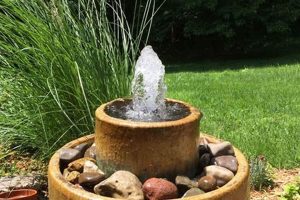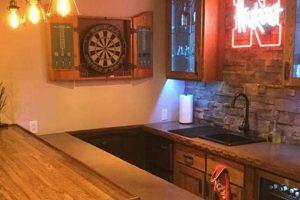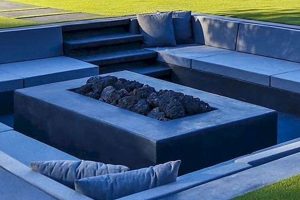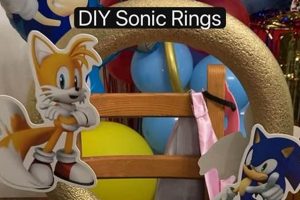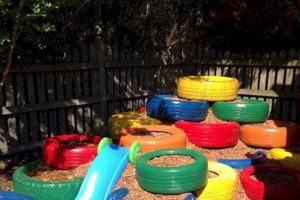The construction of decorative frameworks using inflated spheres has gained considerable traction in event design. These structures, often employed as focal points at celebrations and gatherings, represent an accessible and customizable approach to visual enhancement. A variety of techniques can be applied to their creation, ranging from simple string-and-balloon assemblies to more elaborate frameworks involving specialized support systems.
The appeal of constructing these decorative elements lies in their affordability and versatility. They allow for personalized color schemes, sizes, and shapes, enabling coordination with specific themes or aesthetic preferences. Historically, similar decorative techniques have been utilized to mark significant occasions, reflecting a long-standing desire to visually celebrate milestones and events with customized displays. The current trend presents an opportunity to create memorable atmospheres through accessible means.
The following discussion will explore the fundamental aspects of designing and assembling these structures. It will cover considerations for material selection, framework construction techniques, and design principles that contribute to aesthetically pleasing and structurally sound creations, enabling individuals to confidently undertake such projects.
Essential Considerations for Constructing Balloon Frameworks
The successful assembly of decorative balloon structures relies on careful planning and execution. The following points offer guidance for achieving visually appealing and structurally sound results.
Tip 1: Balloon Selection: Employ balloons of consistent size and material to ensure a uniform appearance and predictable inflation characteristics. Variations can lead to structural imbalances and visual inconsistencies.
Tip 2: Framework Stability: A robust framework is critical. Opt for materials such as PVC pipe or sturdy wire to provide adequate support. Secure all connections to prevent collapse.
Tip 3: Color Harmony: Carefully consider color combinations. Limiting the palette to two or three complementary colors often yields the most aesthetically pleasing results. Gradual color transitions can add visual interest.
Tip 4: Secure Attachment: Use appropriate adhesives or tying techniques to firmly attach balloons to the framework. Ensure that the method chosen does not damage the balloons or compromise their inflation.
Tip 5: Consistent Inflation: Inflate all balloons to the same pressure. Over-inflation can cause bursting, while under-inflation can lead to sagging and an uneven appearance. A balloon pump and sizing tool are recommended.
Tip 6: Environmental Considerations: Account for environmental factors such as temperature and wind. Extreme heat can cause balloons to burst, while strong winds can destabilize the structure. Position and secure accordingly.
Tip 7: Pre-Assembly Testing: Conduct a small-scale test assembly before the final construction. This allows for identification of potential problems and refinement of techniques.
Adhering to these guidelines can significantly improve the structural integrity and visual appeal of decorative balloon assemblies. Careful planning and attention to detail are essential for achieving a professional and lasting result.
The subsequent section will address specific design considerations for creating visually impactful balloon structures.
1. Color Palette Selection
The selection of a color palette is a critical determinant of the overall aesthetic impact of any decorative balloon structure. The chosen colors establish the mood and tone of the structure and, by extension, the event it is meant to enhance. In the context of a do-it-yourself balloon arch project, inappropriate color choices can undermine the intended visual effect, rendering the structure less appealing and potentially detracting from the event atmosphere. Conversely, a well-considered color palette can elevate the structure, making it a focal point and enhancing the overall event aesthetic. For instance, utilizing a monochromatic palette of varying shades of blue can create a calming and sophisticated effect for a corporate event, while a combination of bright, primary colors might be more suitable for a children’s birthday party.
The success of color palette selection in these projects also hinges on an understanding of color theory and how different colors interact. Complementary colors, when used effectively, can create visual interest and dynamic contrast. Analogous colors, on the other hand, offer a harmonious and cohesive aesthetic. Furthermore, cultural and personal preferences also play a significant role. Certain colors may hold specific symbolic meanings or evoke different emotions in different individuals or cultures. Consideration of these factors ensures that the chosen colors align with the intended message and audience.
Ultimately, the careful selection of a color palette is essential for achieving a visually impactful and aesthetically pleasing balloon arch. It’s more than just picking favorite colors. A strategic approach to color selection transforms a simple balloon structure into a sophisticated design element, significantly enhancing the visual appeal and overall success of the celebratory event. Challenges in color palette selection arise from a lack of understanding of color theory or a failure to consider the event’s context and target audience. A thoughtfully selected color palette transforms a simple structure into a visually striking and memorable piece of event decor.
2. Framework Structural Integrity
Framework structural integrity is a foundational element in the successful execution of DIY balloon arch projects. The framework serves as the skeleton upon which the inflated balloons are arranged, and its stability directly impacts the visual appeal and longevity of the final product. A compromised framework can lead to sagging, uneven distribution of balloons, or even complete collapse, negating the time and resources invested in the project. Therefore, meticulous attention to the structural integrity of the framework is paramount.
- Material Selection
The choice of materials for the framework significantly influences its overall strength and stability. Common materials include PVC pipes, metal rods, and sturdy wire. PVC offers a balance of affordability and ease of use but may lack the rigidity required for larger or more complex structures. Metal provides superior strength and is suitable for arches spanning greater distances or those intended for outdoor use. The selection must consider the arch’s dimensions, the weight of the balloons, and the intended environment.
- Joint Construction
The points where framework components connect are critical areas for stru
ctural weakness. Joints must be securely fastened using appropriate connectors, adhesives, or welding techniques. Insufficiently secured joints can buckle under the weight of the balloons, leading to instability. For PVC frameworks, specialized fittings designed for creating strong, right-angled connections are essential. For metal frameworks, welding or the use of threaded fasteners provides a robust connection. - Load Distribution
An effective framework design distributes the weight of the balloons evenly across its structure. This minimizes stress on individual components and prevents localized points of failure. Incorporating support elements such as vertical supports or cross braces can enhance load distribution, particularly in larger or more complex designs. Proper planning of the arch’s geometry, considering the number and size of balloons, is crucial for optimizing load distribution.
- Environmental Resistance
For arches intended for outdoor use, the framework must be able to withstand environmental factors such as wind and temperature fluctuations. Strong winds can exert significant force on the structure, requiring additional anchoring and reinforcement. Temperature changes can cause materials to expand or contract, potentially weakening joints or causing components to warp. Choosing weather-resistant materials and employing robust construction techniques are essential for ensuring the arch’s stability in outdoor settings.
In conclusion, framework structural integrity is not merely a technical detail but a core determinant of the success of DIY balloon arch endeavors. From material selection and joint construction to load distribution and environmental resistance, each facet contributes to the overall stability and aesthetic appeal. A well-engineered framework provides a solid foundation for a visually striking and long-lasting decorative element, enhancing the celebratory atmosphere of any event.
3. Balloon Size Consistency
Balloon size consistency is a crucial element within the realm of do-it-yourself balloon arch construction. The dimensional uniformity of individual balloons directly impacts the overall aesthetic appeal and structural integrity of the finished arch. Variances in balloon size create visual irregularities, disrupt the smooth curvature of the arch, and potentially compromise its stability, as unevenly inflated balloons exert unequal pressure on the supporting framework. For example, an arch intended to exhibit a flowing, symmetrical form can appear disjointed and unbalanced if the balloons are inflated to differing diameters. This is because size discrepancies disrupt the intended density and spacing, resulting in a visually fragmented and less impressive structure. The absence of uniform inflation can lead to sagging or distortion of the arch, particularly in sections where smaller balloons are adjacent to larger ones, creating weak points susceptible to collapse.
The practical significance of maintaining balloon size consistency extends beyond mere visual appeal. It influences the amount of tension distributed across the framework. Uneven inflation leads to an uneven distribution of weight and stress, potentially exceeding the structural capacity of certain framework components. This is especially critical in larger arches or those utilizing less robust framework materials. The use of balloon sizing tools, such as templates or sizers, is therefore recommended to ensure that each balloon is inflated to the desired diameter. Furthermore, consistent inflation techniques, employing calibrated air pumps or inflation devices, further contribute to the uniformity of the balloons. Neglecting these precautions can result in an arch that is not only aesthetically flawed but also structurally unsound, presenting potential safety hazards if it collapses during an event.
In summary, dimensional uniformity in balloon inflation is fundamental to achieving a visually pleasing and structurally stable balloon arch. The consequences of neglecting this aspect range from aesthetic imperfections to potential structural failures. By employing appropriate sizing tools, consistent inflation techniques, and careful attention to detail, individuals can significantly enhance the quality and durability of their DIY balloon arch creations, ensuring a visually impressive and structurally sound decorative element for any occasion. The challenges associated with achieving balloon size consistency highlight the need for precision and attention to detail throughout the arch construction process.
4. Inflation Pressure Regulation
Precise inflation pressure regulation is a critical determinant of both the aesthetic appeal and structural integrity of decorative balloon structures. The uniformity of inflated spheres is directly influenced by the consistency of the internal pressure. Deviations from the optimal pressure, whether over-inflation or under-inflation, can lead to visual inconsistencies and compromise the structural stability of the assembly. For example, balloons inflated beyond their recommended capacity are at a heightened risk of rupture, while under-inflated balloons may lack the necessary rigidity to maintain the intended shape and density of the structure. The application of pressure regulation techniques mitigates these risks, contributing to a more visually cohesive and structurally sound final product.
The practical application of inflation pressure regulation extends beyond simple visual considerations. It impacts the longevity of the structure and its ability to withstand environmental factors. Consistent pressure across all balloons ensures an even distribution of stress on the framework. This balanced distribution minimizes the likelihood of localized failures and extends the overall lifespan of the decorative element. Furthermore, regulated inflation enhances the structure’s resilience to external forces, such as wind, which can destabilize unevenly inflated assemblies. The use of pressure gauges and calibrated inflation devices is essential for achieving this level of precision. For instance, the inflation of individual balloons to precisely 90% of their maximum capacity ensures both optimal shape and reduced risk of bursting due to temperature fluctuations.
In summary, effective inflation pressure regulation represents a fundamental aspect of constructing durable and visually appealing balloon structures. Challenges in maintaining consistent pressure can arise from variations in balloon material, ambient temperature, and the accuracy of inflation equipment. Addressing these challenges through the use of calibrated tools and meticulous attention to detail is essential for achieving a professional and lasting result. Therefore, a thorough understanding and careful application of pressure regulation principles significantly contribute to the success of any decorative balloon structure project.
5. Attachment Method Efficacy
The efficacy of the attachment method directly influences the structural integrity and aesthetic longevity of DIY balloon arch constructions. The chosen technique determines how securely balloons are affixed to the supporting framewor
k. A deficient attachment method can lead to premature detachment of balloons, resulting in an incomplete or visually compromised arch. Conversely, a robust and well-executed attachment strategy ensures that balloons remain firmly in place, maintaining the intended design and extending the arch’s lifespan. The selection of an appropriate attachment method is therefore a critical consideration in DIY balloon arch projects. For example, using a low-quality adhesive may result in balloons detaching within hours, particularly in environments with temperature fluctuations, while employing a secure tying technique with durable monofilament line can maintain the structure for several days.
Several factors influence the selection of an appropriate attachment method. The type of framework material, the size and material of the balloons, and the intended duration of the display all play a role. Common attachment methods include tying balloons directly to the framework, using adhesive dots or strips, and employing specialized balloon clips or connectors. Direct tying offers a secure and economical solution but can be time-consuming. Adhesive dots provide a faster alternative but may not be suitable for heavier balloons or frameworks with smooth surfaces. Balloon clips offer a reusable and adjustable option but require an initial investment in specialized hardware. The environment in which the arch will be displayed also influences the optimal attachment method. Outdoor arches require more robust techniques to withstand wind and other environmental factors. The improper selection of attachment methods causes the entire balloon arch to fail and will be detrimental to time, labor and money.
In conclusion, the efficacy of the chosen attachment method is an indispensable component of successful DIY balloon arch projects. A thorough understanding of the available attachment options, their relative strengths and weaknesses, and the specific demands of the project is essential for ensuring a visually appealing and structurally sound final product. The failure to adequately address attachment concerns can negate the time, effort, and resources invested in the project, resulting in a disappointing and short-lived display. The relationship between a robust attachment strategy and a durable, aesthetically pleasing balloon arch underscores the importance of meticulous planning and execution in all aspects of DIY construction. Neglecting the importance of attachment efficancy can result in an unsightly and quickly deteriorating display, undermining the overall impact of the event decoration.
Frequently Asked Questions Regarding DIY Balloon Arch Construction
The following addresses common inquiries concerning the planning, execution, and maintenance of decorative frameworks utilizing inflated spheres.
Question 1: What is the optimal material for constructing a structurally sound framework?
The selection of framework material depends on the size and intended location of the arch. PVC pipe offers a balance of affordability and workability for indoor arches. Metal conduit provides greater strength and is recommended for larger outdoor installations.
Question 2: How can balloon size consistency be ensured during inflation?
Employing a balloon sizing tool or template is crucial. Consistent inflation pressure can be achieved by using a calibrated electric air pump. Manual inflation is generally not recommended due to potential inconsistencies.
Question 3: What adhesive options are most effective for securing balloons to the framework?
Double-sided adhesive dots designed specifically for balloon adhesion provide a secure and aesthetically clean attachment method. Liquid adhesives are generally discouraged due to potential damage to the balloons.
Question 4: How can the lifespan of a balloon arch be maximized, particularly in outdoor environments?
Minimize exposure to direct sunlight, which can cause balloons to degrade and burst. Secure the framework to prevent movement due to wind. Consider using outdoor-rated balloons, which are more resistant to UV damage.
Question 5: What are the primary safety considerations when constructing a balloon arch?
Avoid over-inflation of balloons, as this increases the risk of bursting. Ensure the framework is stable and well-anchored to prevent collapse. Supervise children and pets to prevent accidental ingestion of balloons or framework components.
Question 6: How is transportation of a completed balloon arch best managed?
Disassembly into smaller, manageable sections is generally recommended. Transport the framework separately from the inflated balloons. Reassembly at the final location minimizes the risk of damage during transit.
Careful planning, attention to detail, and adherence to safety guidelines are essential for successful DIY balloon arch construction.
The subsequent section will provide advanced techniques for creating visually intricate and structurally robust decorative balloon structures.
Conclusion
The preceding exploration of constructing decorative frameworks with inflated spheres has underscored several crucial elements for successful implementation. The significance of material selection, framework stability, balloon size consistency, inflation pressure regulation, and attachment method efficacy has been thoroughly examined. A meticulous approach to each of these factors is essential for achieving visually appealing and structurally sound outcomes.
Mastery of these principles empowers individuals to create impressive celebratory displays through these accessible construction techniques. The ability to design and assemble such structures offers a means of enhancing events with customized aesthetics and memorable visual impact. Continued refinement of these methods will further advance the potential of these design techniques within event decor.



